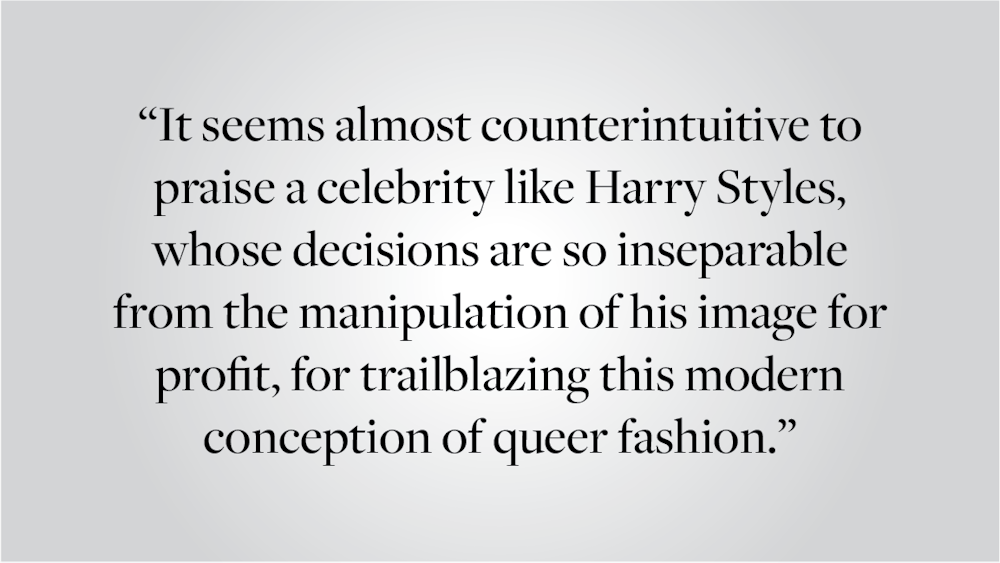Clothing has always been a form of gender expression. For queer people, fashion can serve as resistance against the gender binary and a performance that works to destabilize heteropatriarchal norms. Entertainers, as performers by nature, have often stood at the forefront of the mainstream movement toward more gender-fluid dressing. Figures like David Bowie and Freddie Mercury are examples of people who have crafted their images around eccentric, queer expression through clothing. In an increasingly progressive 21st century, performers who reject the gender binary through their clothing have become almost ubiquitous in pop culture. Yet there is danger in the continued sensationalization of gender-fluid fashion. When celebrities are seen as the standard bearers in the fight against cisheteronormativity because of their androgynous fashion choices, we can risk commodifying free gender expression. Using queer fashion for profit dilutes its meaningfulness as an authentic expression of identity.
In the modern entertainment industry, a prime example of someone who is praised as a gender-bending fashion icon is singer Harry Styles. From the lacy Gucci dress he wore on the December 2020 Vogue cover to the feather boas he donned at the Grammys, Styles’s fashion choices have garnered both praise and criticism for their femininity and flamboyance. His fashion has taken mainstream pop culture by storm, and he has quickly become one of the most — if not the most — prominent modern celebrities spearheading gender-fluidity in the fashion industry.
Styles’s progressive wardrobe deserves to be celebrated. Every bold fashion choice he and his team make is a testament to his strength and vision in rejecting norms that pigeonhole men into masculine, heterosexual forms of expression. Compared to other performers of his fame and caliber, the image he has crafted for himself is unique and bold.
But there are aspects of Styles’s fame which dilute the impact of his progressive dressing. Despite being vocal about gender-fluid fashion and the importance of authentic self-expression, Styles has nevertheless benefited from breaking boundaries initially tested by marginalized queer people who remain less visible in the movement. It was trans women of color who spearheaded the movement for LGBTQ+ rights and who fostered a culture where Styles could dress boldly. Still, he is being praised as a trailblazer of the queer fashion movement. It is impossible to accept Styles’s position as an iconic and game-changing entertainer without acknowledging the white and cisgender privilege that allowed him to get there.
This is not to say that Styles is disingenuous in his exploration of gender-fluid fashion. But it is worth noting that a celebrity like Styles, who has become so saturated in modern pop culture, has a marketable and malleable image that can be easily exploited in the name of profit. The reality is that every public move Styles (and any other celebrity of his caliber) makes is thoroughly examined on the basis of whether it will be good for his image, and, therefore, his fame. This includes his fashion choices. It seems almost counterintuitive to praise a celebrity like Harry Styles, whose decisions are so inseparable from the manipulation of his image for profit, for trailblazing this modern conception of queer fashion.
Queer self expression in clothing should be about refusal — the refusal of normativity, of straightness and of the gender binary. Because Styles is such a massive pop culture figure whose image earns him profit, it is unclear to what extent his gender expression is an authentic attempt to destabilize heteropatriarchal power structures and to what extent it is a marketable aspect of his personality. When queer dress is so interconnected with the exploitation of his image for capital gain, we risk commodifying queer self expression. This is dangerous because we then diverge from the anti-normativity that gender-fluid self expression fundamentally represents. Profit-oriented queer self-expression takes away from this crucial focus on refusal. It thus loses its political power as a middle-finger to established norms.
Whether or not Styles is genuine in his true exploration of queer and nonbinary fashion, it is nonetheless dangerous to equate free gender exploration and queer performance with a dress that a celebrity wears on the cover of a famous magazine. The former is politically meaningful, whereas the latter is primarily designed for mass consumption. Individuals should be encouraged to explore free gender expression through fashion. But with a celebrity culture that is so oversaturated in our everyday lives, it is dangerous to consider celebrities — especially white, cisgender ones — to be the leaders in this fight. As much as queer dress is a form of performance for so many, it is also a form of protest. That aspect is lost when gender-fluid and queer fashion looks mostly like a shallow aspect of a celebrity’s public image.
Melissa Liu ’25 can be reached at melissa_y_liu@brown.edu. Please send responses to this opinion to letters@browndailyherald.com and other op-eds to opinions@browndailyherald.com.





